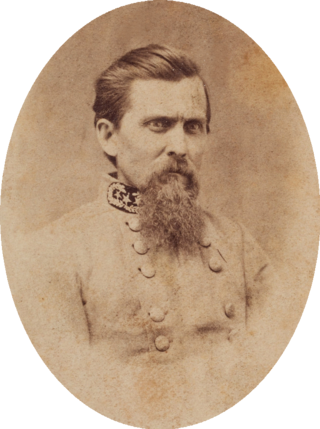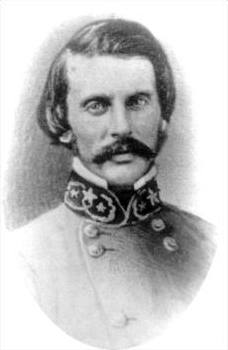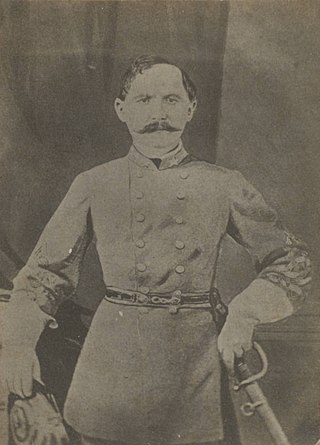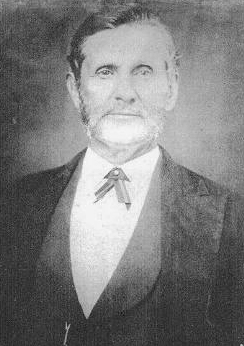
The Battle of Monett's Ferry or Monett's Bluff saw a Confederate States Army force led by Brigadier General Hamilton P. Bee attempt to block a numerically superior Union Army column under Brigadier General William H. Emory during the Red River Campaign of the American Civil War. Confederate commander Major General Richard Taylor set a trap for the retreating army of Major General Nathaniel P. Banks near the junction of the Cane River with the Red River. Taylor assigned Bee's troops to plug up the only outlet from the trap while Taylor's other forces closed in from the rear and sides.

Major-General John George Walker was a Confederate general in the American Civil War. He served as a brigadier general under Stonewall Jackson and James Longstreet, before commanding the Texas Division unit in the Trans-Mississippi Department, known as Walker's Greyhounds for their speed and agility. He was ordered to disrupt U.S. Grant's supply-line opposite Vicksburg, Mississippi, but Grant had managed to cross to the East Bank, and Walker was reduced to minor operations, one of them against some of the first African-American troops to serve in battle. He was able to make a bigger contribution to the Red River Campaign in support of General Richard Taylor.

Walker's Greyhounds was the popular name for a division of the Confederate States Army under Major-General John George Walker, composed exclusively of units from Texas. It fought in the Western Theater and the Trans-Mississippi Department, gaining its nickname because the men were able to move long distances rapidly on foot.
The Company A, Arizona Rangers was a cavalry formation of the Confederate States Army during the American Civil War.

James Edward Harrison was a Confederate States Army brigadier general during the American Civil War. He served in the Trans-Mississippi Department and fought in campaigns in Louisiana. Before the war, he was a two-term Mississippi state senator before moving to Texas in 1857. After the war, he was a trustee of Baylor University.

The 1st Missouri Cavalry Regiment was a cavalry regiment that served in the Confederate States Army during the American Civil War.

The 9th Texas Infantry Regiment was a unit of Confederate States Army infantry volunteers organized in December 1861 that fought during the American Civil War. The regiment fought at Shiloh, Perryville, and Stones River in 1862, Chickamauga in 1863, the Atlanta Campaign, Allatoona, and Nashville in 1864, and Spanish Fort and Fort Blakeley in 1865. The remaining 87 officers and men surrendered to Federal forces in May 1865. Two of the regiment's commanding officers were promoted brigadier general.

The 12th Texas Cavalry Regiment was a unit of mounted volunteers recruited in Texas that fought in the Confederate States Army during the American Civil War. The regiment was enrolled in state service in September 1861 and in Confederate service the following month. The regiment fought at Whitney's Lane, Cotton Plant, and L'Anguille Ferry in 1862, Goodrich's Landing in 1863, and Blair's Landing and Yellow Bayou in 1864. The unit also participated in numerous skirmishes and scouts. It disbanded in May 1865.

The 28th Texas Cavalry Regiment was a unit of mounted volunteers recruited in east Texas that fought in the Confederate States Army during the American Civil War. In May 1862, the regiment entered Confederate service and served the entire war west of the Mississippi River in the region known as the Trans-Mississippi Department. The unit was soon dismounted before being assigned to the 2nd Brigade of the all-Texas infantry division known as Walker's Greyhounds. In 1863, the regiment played a secondary role at Milliken's Bend. The regiment fought in three major battles during April 1864, at Mansfield, Pleasant Hill, and Jenkins' Ferry. The Trans-Mississippi Department surrendered on 26 May 1865, but the survivors dispersed to their homes before that date.

The 2nd Louisiana Cavalry Regiment was a unit of mounted volunteers recruited in Louisiana that fought in the Confederate States Army during the American Civil War. Breazeale's Cavalry Battalion was formed in July 1862 and was augmented by five additional companies in September 1862 to form a regiment. It served for the entire war west of the Mississippi River in the Trans-Mississippi Department. The regiment fought at Georgia Landing, Fort Bisland, Irish Bend, and Brashear City in 1863 and Henderson's Hill and Mansfield in 1864. Afterward, the regiment fought in minor skirmishes before the Trans-Mississippi's final surrender on 26 May 1865.

The 7th Texas Cavalry Regiment was a unit of mounted volunteers from Texas that fought in the Confederate States Army during the American Civil War. In the summer of 1861, the regiment was organized and mustered into Confederate service. In November 1861, it was assigned to a brigade that was tasked with capturing New Mexico Territory. In 1862, the regiment served in the unsuccessful New Mexico Campaign. In 1863, it was in action at Galveston, Second Donaldsonville, Kock's Plantation, and Bayou Bourbeau. In 1864, the regiment fought at Mansfield and Pleasant Hill in the Red River Campaign. The unit disbanded while in Texas in May 1865.

The 22nd Texas Cavalry Regiment was a unit of mounted volunteers from Texas that fought in the Confederate States Army during the American Civil War. The regiment first began organizing in late 1861 and by July 1862, it moved to the Indian Territory. The unit fought at Newtonia and McGuire's Store in fall 1862 and was dismounted soon after. The regiment fought as infantry at Prairie Grove in December 1862. It traveled to Louisiana in March 1863 where it joined a brigade led by Camille de Polignac. In 1864 the regiment fought at Mansfield, Pleasant Hill, and Yellow Bayou during the Red River Campaign. In March 1865 the regiment marched to Texas where it disbanded in May.

The 19th Texas Cavalry Regiment was a unit of mounted volunteers from Texas that fought in the Confederate States Army during the American Civil War. The regiment mustered into Confederate service at the end of March 1862. It moved to Arkansas in fall 1862 and managed to avoid being dismounted as infantry, instead serving in William Parsons' cavalry brigade. The regiment fought at Cape Girardeau in 1863. The unit operated against Union supply lines and skirmished with Union forces in Arkansas and Louisiana. It arrived too late to take part in the main battles of the Red River campaign of 1864, but fought at Yellow Bayou. In 1865, the unit moved to Texas where it disbanded in May 1865.

The 1st Texas Cavalry Regiment was a unit of mounted volunteers from Texas that fought in the Confederate States Army during the American Civil War. It was first organized as a 10-company regiment by Colonel Henry Eustace McCulloch in April 1861 and named the 1st Texas Mounted Rifles. In early May 1861, the regiment secured the surrender of the small Federal garrison of San Antonio. Except from a skirmish with Native Americans in November 1861, the regiment took part in no more actions. In April 1862, the unit was reduced to five companies and renamed the 8th Texas Cavalry Battalion. On 2 May 1862, William Overall Yager's 3rd Texas Cavalry Battalion was consolidated with the 8th Cavalry Battalion to form a new 1st Texas Cavalry Regiment under Colonel Augustus Buchel, a German soldier of fortune who emigrated to Texas in 1845. The regiment served on the Texas Gulf Coast in 1863 but later transferred to Louisiana. In 1864, it fought at Mansfield, Pleasant Hill, and Yellow Bayou in the Red River Campaign. After Buchel was killed at Pleasant Hill, Yager led the regiment for the rest of the war. The unit was included in the 2 June 1865 surrender.

The 31st Texas Cavalry Regiment was a unit of mounted volunteers from Texas that fought in the Confederate States Army during the American Civil War. Trevezant C. Hawpe organized the regiment in early 1862 with recruits mostly from Dallas County, Texas, and surroundings. In June 1862, it marched to Arkansas where it joined a brigade led by Douglas H. Cooper. The unit fought at Newtonia and McGuire's Store in autumn 1862 and subsequently dismounted to serve as infantry. The regiment served at Prairie Grove in December 1862. It moved to Louisiana in February 1863 at which time Hawpe resigned. The unit helped defeat a Federal force at Stirling's Plantation in September 1863. The following month it joined a brigade led by Camille de Polignac. In 1864 the regiment fought at Mansfield, Pleasant Hill, and Yellow Bayou during the Red River Campaign. In March 1865 the regiment marched to Texas where it disbanded in May.

The 34th Texas Cavalry Regiment was a unit of mounted volunteers from Texas that fought in the Confederate States Army during the American Civil War. Almerine M. Alexander organized the regiment from north Texas recruits in the winter of 1861–1862. The unit marched to Indian Territory in May 1862 where it joined a brigade commanded by Douglas H. Cooper. The regiment fought at Newtonia and McGuire's Store in fall 1862 afterward was dismounted. The regiment served as infantry at Prairie Grove in December 1862. It received orders to transfer to Louisiana in April 1863. The regiment joined a brigade led by Camille de Polignac in July 1863. The following year, the unit fought at Mansfield, Pleasant Hill, and Yellow Bayou during the Red River Campaign. In March 1865 the regiment was assigned to the Texas Infantry Division. Soon after, it marched to Texas where it disbanded in May 1865.
The 36th Texas Cavalry Regiment was a unit of mounted volunteers from Texas that fought in the Confederate States Army during the American Civil War. The regiment was organized in March 1862 at Belton, Texas and surgeon Peter C. Woods was appointed to command it. The unit patrolled the Texas Gulf Coast and then spent the winter of 1862–1863 at Port Lavaca, Texas. It marched to Brownsville, Texas, in spring 1863 and later joined Hamilton P. Bee's brigade. This brigade transferred to Louisiana where it fought at Mansfield, Pleasant Hill, Blair's Landing, and Yellow Bayou during the Red River campaign in 1864. Afterward, the regiment traveled to Crockett, Texas, and then Galveston, where it was present when the men were paroled in June 1865.

The 1st Louisiana Field Battery was an artillery unit recruited from volunteers in Louisiana that fought in the Confederate States Army during the American Civil War. The battery mustered into Confederate service in October 1861. The unit traveled to Fort Jackson in early 1862 and took part in the defense of Forts Jackson and St. Philip. The soldiers became prisoners when the forts surrendered and the battery reformed at Franklin after their prisoner exchange. The battery fought at Fort Bisland and Irish Bend in 1863. Later in the year the battery engaged Union shipping on the rivers in several actions. In 1864 the battery briefly fought at Mansfield before its commander was killed while engaging Union gunboats on the Red River. The unit also fought at Mansura and Yellow Bayou. The battery was in Texas when the Trans-Mississippi Department surrendered in May 1865.

The 1st Texas Partisan Rangers was a unit of mounted volunteers from Texas that fought in the Confederate States Army during the American Civil War. Walter P. Lane began organizing the unit at Jefferson, Texas, in June 1862 for service in the Trans-Mississippi theater. In November 1862, the regiment marched to Arkansas where it fought at Prairie Grove and Van Buren. After reorganizing at Jefferson, the partisan rangers traveled to Louisiana in April 1863. The regiment was at Second Donaldsonville but did not come into action. In 1863, it fought at Kock's Plantation, Sterling's Plantation, and Bayou Bourbeux. The unit spent the 1863–1864 winter near Galveston. In 1864, the unit was in action during the Red River Campaign, fighting at Mansfield, Pleasant Hill, Monett's Ferry, and Yellow Bayou. The partisan rangers went back to Texas in December 1864 and remained near Houston until the surrender of the Trans-Mississippi Department on 26 May 1865.

The 2nd Texas Partisan Rangers was a unit of mounted volunteers from Texas that fought in the Confederate States Army during the American Civil War. B. Warren Stone began organizing the unit at Dallas in October 1862 with the permission of Confederate States Secretary of War George W. Randolph. In March 1863, the regiment marched to Houston and the following month it traveled to Louisiana as part of James Patrick Major's brigade. Soon after, Stone was replaced as colonel by Isham Chisum. The regiment fought at Second Donaldsonville, Kock's Plantation, Sterling's Plantation, and Bayou Bourbeux. In 1863–1864, the unit wintered near Galveston. In 1864, the 2nd Partisan Rangers were in action at Mansfield, Pleasant Hill, Monett's Ferry, and Yellow Bayou during the Red River Campaign. The partisan rangers went back to Texas in December 1864 and usually camped at Houston until the surrender of the Trans-Mississippi Department on 26 May 1865.


















